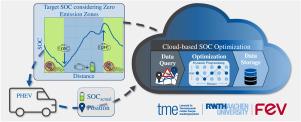Cloud-based SOC optimization for predictive energy management and zero emission zone compliance in PHEVs
IF 17
1区 工程技术
Q1 ENERGY & FUELS
引用次数: 0
Abstract
With deteriorating air quality in many cities worldwide failing to meet World Health Organization (WHO) standards, effective countermeasures are urgently needed. In response, cities are implementing zero-emission zones, restricting entry to only zero-emission vehicles like Battery Electric Vehicles and Fuel Cell Electric Vehicles. These measures aim to reduce urban air pollution and improve public health significantly. Despite their ability to operate in pure electric mode under city driving conditions, Plug-in Hybrid Electric Vehicles (PHEVs) are typically prohibited from zero-emission zones due to the potential use of their Internal Combustion Engines, which could compromise air quality improvement efforts. However, advancements in digital maps and Vehicle-to-Everything (V2X) technology present a viable solution to this challenge. Geofencing technology can now be employed to carefully plan and prepare PHEVs’ battery State of Charge (SOC), ensuring that SOC usage is strictly restricted within zero-emission zones.
This study proposes a predictive control strategy for PHEVs, utilizing route information from digital map providers to enable electric driving within zero-emission zones. To achieve this, a supervisory control with Dynamic Programming (DP) is developed in the upper layer to calculate an optimal SOC trajectory considering the zero-emission zone and guide the rule-based controller in the lower level. The high computational effort of DP is addressed by running it in the cloud. In addition, the optimization can be repeated multiple times during driving. The proposed methodology is tested and validated on a demonstrator vehicle in a real-world drive cycle.

基于云的SOC优化,用于插电式混合动力汽车的预测性能源管理和零排放区合规
随着世界上许多城市的空气质量不断恶化,未能达到世界卫生组织(世卫组织)的标准,迫切需要采取有效的对策。作为回应,各城市正在实施零排放区,限制纯电动汽车和燃料电池电动汽车等零排放车辆进入。这些措施旨在减少城市空气污染,显著改善公众健康。尽管插电式混合动力汽车(phev)能够在城市驾驶条件下以纯电动模式运行,但由于其内燃机的潜在使用可能会影响空气质量改善,因此通常禁止进入零排放区。然而,数字地图和车联网(V2X)技术的进步为这一挑战提供了可行的解决方案。地理围栏技术现在可以用于精心规划和准备插电式混合动力车的电池充电状态(SOC),确保SOC的使用严格限制在零排放区域内。本研究提出了一种插电式混合动力车的预测控制策略,利用数字地图提供商提供的路线信息,在零排放区域内实现电动驾驶。为了实现这一目标,在上层开发了一种基于动态规划(DP)的监督控制,以计算考虑零排放区域的最优SOC轨迹,并指导下层基于规则的控制器。DP的高计算量是通过在云中运行来解决的。此外,该优化可以在驾驶过程中多次重复。所提出的方法在一辆真实驾驶循环的演示车上进行了测试和验证。
本文章由计算机程序翻译,如有差异,请以英文原文为准。
求助全文
约1分钟内获得全文
求助全文
来源期刊

Etransportation
Engineering-Automotive Engineering
CiteScore
19.80
自引率
12.60%
发文量
57
审稿时长
39 days
期刊介绍:
eTransportation is a scholarly journal that aims to advance knowledge in the field of electric transportation. It focuses on all modes of transportation that utilize electricity as their primary source of energy, including electric vehicles, trains, ships, and aircraft. The journal covers all stages of research, development, and testing of new technologies, systems, and devices related to electrical transportation.
The journal welcomes the use of simulation and analysis tools at the system, transport, or device level. Its primary emphasis is on the study of the electrical and electronic aspects of transportation systems. However, it also considers research on mechanical parts or subsystems of vehicles if there is a clear interaction with electrical or electronic equipment.
Please note that this journal excludes other aspects such as sociological, political, regulatory, or environmental factors from its scope.
 求助内容:
求助内容: 应助结果提醒方式:
应助结果提醒方式:


